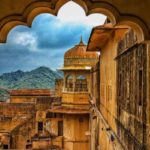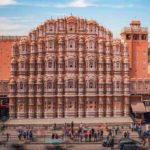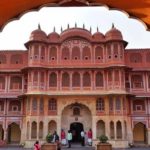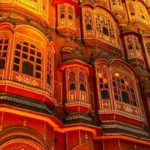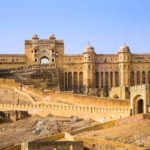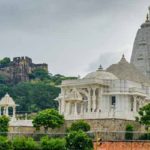City Palace Jaipur is one of the most famous tourist attractions located in the old part of the city. Built by Maharaja Sawai Jai Singh during the years 1729 to 1732, the vast complex of the palace occupied one-seventh of the walled city. In fact, it was once the seat of the Maharaja of Jaipur. The palace is divided into a series of courtyards, buildings and gardens including the Chandra Mahal and the Mubarak Mahal. The museum showcases various unique handcrafted products and other things that belong to the royal heritage of the City Palace.
The facade itself is designed with acute and detailed handiwork and showcases a blend of Mughal and Rajput architecture styles. The outer wall was built by Jai Singh II, however, the palace itself has been subjected to various changes over the course of time, with some of them even belonging to the early 20th century. The City Palace has three gates, out of which the Virendra Pol and Udai Pol are open to the public.
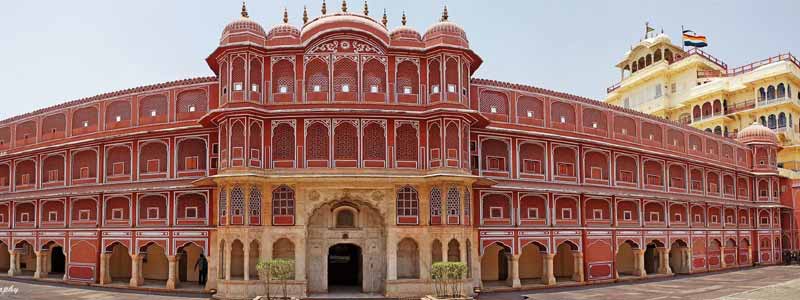
History of City Palace
City Palace Jaipur is a palace complex, which used to be the seat of the Maharaja of Jaipur, the head of the Kachhawaha Rajput clan. The palace complex is made up of an impressive and vast array of courtyards, gardens and buildings. The palace was built between 1727 and 1732 by Sawai Jai Singh II, the founder of Jaipur Attractions.
City Palace Jaipur has served as the principal residence of the Kachhawaha rulers since 1727, when Maharaja Sawai Jai Singh II initiated work on it. The vast complex is contained by high walls with monumental arched gateways on three sides providing access to the broad bazaar streets of the city.
City Palace Jaipur is built in the typical Rajput style with fretted screens and fragile pillars supporting carved balconies, and still serves to house members of the ruling family.
It was in this palace that the Maharajas of Jaipur were installed, on the early 18th century gadi, a wooden frame covered with silver plate. Fans of yak-tails and peacock feathers are the symbols of state, held by attendants on formal occassions, while a golden howdah on display was used in 1961 by Queen Elizabeth of Great Britain and the last Maharaja. Surya, the Sun God, is shown flanked by two lions, and peacocks adorn the doors.
Sawai Man Singh II was the last Maharaja of Jaipur to rule from City Palace Jaipur. However, this palace continued to be a residence of the royal family even after Jaipur became a part of the Indian Union in 1949. Jaipur became the capital of the Indian state of Rajasthan, and Man Singh II became the Rajapramukh (present day Governor of Jaipur) for a time and later was the Ambassador of India to Spain Jaipur Tour Packages.
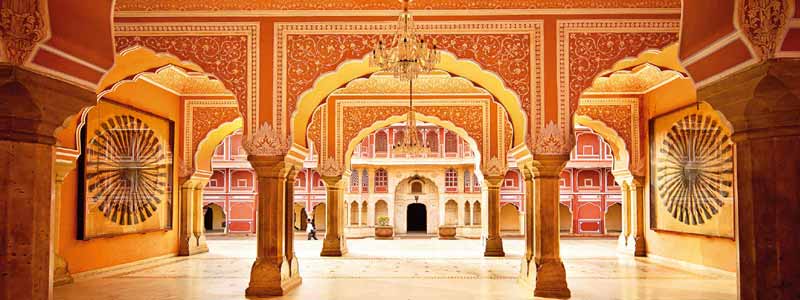
Architecture of City Palace
The architectural style of the City Palace was a fusion of the Shilpa Shastra of Indian Architecture along with Rajput, Mughal and European styles. The main architects for the construction of the palace were Vidyadhar Bhattacharya and Sir Samuel Swinton Jacob. Classical Indian principles such as the Vastushastra were promptly followed by the architects during the construction of the palace. It was built using red and pink sandstone and has three gates, namely ‘Tripolia Gate’, ‘Udai Pol’, ‘Virendra Pol’.
The entrances themselves are decorated intricately with the finest handiwork and are a suitable preamble to what lies inside. The palace complex is designed in the form of a grid and has a number of structures within its bounds such as ‘Chandra Mahal’, ‘Govind Dev Ji Temple’, ‘Mubarak Mahal’, and ‘Diwan-I-Khas’. Murals, mosaics, honeycomb window panes and meticulous stonework make the Palace a perfect blend of design, art, colour and culture.

Places to visit near City Palace –
There are several historical monuments near the City Palace Jaipur.
Jantar Mantar: It is the closest monument to the City Palace. You will find the ticket counter right in front of the gate you used for exit, and the monument is across the road on your right-hand side.
It is a must-see place which houses various examples of traditional techniques of watching the time, measuring objects in the air, etc.
Hawa Mahal: The palace is settled right in the middle of the road spreading the vibes of Rajputana elegance through its structure.
However, initially the Hawa Mahal was a part of the City Palace Jaipur and hence you will not find any gate going inside the palace from the main road.
You must enter the palace from behind, to know how the royal ladies from the bygone era used to witness the everyday life and celebrations of the festivals.
Albert Hall Museum: The museum is appreciated not only for its variety of antique collection but even for its architecture. You should click a picture from the outside and then enter the museum to witness an array of artefacts kept inside it.
Make sure to consume all of your evening and wait till dusk to finish the inside tour, only to be rewarded by the picturesque beauty of the colourfully lit monument.
Nahargarh Fort: This is the best place to witness the entire city of Jaipur. This ancient ruin of a beautiful fort creates the best aura to spend some time in silence. You must go here early in the morning and wait for the sunrise.
Jal Mahal: Jal Mahal is an elegant palace constructed half-submerged inside the man-made lake called Man Sagar Lake. It is beautiful in its real sense and the sight of a nicely lit palace in the middle of the lake is delightful and divine.
Best Time To Visit City Palace
The morning and evening hours and cooler and less crowded. Winter months of October – March are the best months to visit this destination.
How To Reach City Palace, Jaipur
You can easily reach the City Palace Jaipur from any part of Jaipur, as various modes of transportation such as auto rickshaw, taxi or public bus are quite frequently available to this destination. You can also book cabs from any point in the city.


